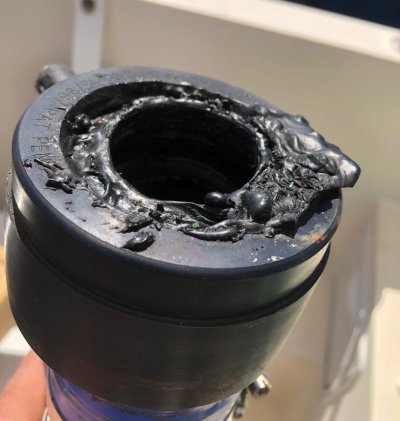ctjstr
Senior Member
- Joined
- Nov 24, 2017
- Messages
- 399
- Location
- United States
- Vessel Name
- "Convergence"
- Vessel Make
- Camano Troll
Funny the emotions that play out, even in a relatively benign situation.
We were headed up to the Camano gathering on Pender Island in BC on Saturday. Left Tacoma about 10 and pulled into the marina in Port Townsend about 4 pm. As we're docking, Sara hears water running. Look around and its a pretty good stream (light garden hose?) running out of our boat. Ooops, dat be the bilge pump. Did some investigation and lo and behold, we've got a bunch of water coming through the formerly dripless shaft seal. Enough so it keeps the bilge pump running about 60% of the time.
Check with the haul out guys at Boat Haven marina. Sure, we can call guys in and pull your boat as an emergency, but you still can't get parts etc until Monday. Or, you could leave it in the water, watch the pump, and we'll pull it Monday at about half the price.
So we decided to wait until Monday. We had the lift guys' cell phone numbers and they promised to get us out promptly if things got worse.
Tied up and enjoyed the town for a couple days. On Sunday afternoon, noticed that the water was coming out from the opposite side of the boat. Huh. Only dawned on my in the middle of the night that the switch was caused b a failed bilge pump. water rose over a small bulkhead to the next compartment, where that bilge took over. So NOW I'm concerned. Naturally didn't sleep a wink the rest of that night.
Bright and early Monday boat is out and on the dirt. Pulled the seal loose and slid it forward. Was able to slide the shaft back enough so that the seal could come off without pulling the shaft. The seal was melted into a big blob. Hot enough to mark up the shaft pretty well. Fortunately, Fisheries had a Sure Seal in the right size, which they shipped over to Pt Townsend for free. Back together and in the water by Tuesday afternoon.
Failure was caused by something blocking the water flow into the seal. There is a gravity feed water line coming off the aftercooler that feeds the seal. Once that plugged, the seal just plain melted.
Had zero warning on this. Not a drop of water before we started the trip. On the Camanos that seal is way back in a recess pretty deep in the keep form hull, making it harder as hell to get to.
the new seal has two water inlets, which lessens the liklihood of both being plugged. It also has a spare seal fastened to the shaft in front of the one in use, making a change out pretty painless.
The only think I can think of to try and anticipate
this more is to use an infrared gun to check the temp of the shaft while running.
sorry about the large photo, but its of the seal after removal
We were headed up to the Camano gathering on Pender Island in BC on Saturday. Left Tacoma about 10 and pulled into the marina in Port Townsend about 4 pm. As we're docking, Sara hears water running. Look around and its a pretty good stream (light garden hose?) running out of our boat. Ooops, dat be the bilge pump. Did some investigation and lo and behold, we've got a bunch of water coming through the formerly dripless shaft seal. Enough so it keeps the bilge pump running about 60% of the time.
Check with the haul out guys at Boat Haven marina. Sure, we can call guys in and pull your boat as an emergency, but you still can't get parts etc until Monday. Or, you could leave it in the water, watch the pump, and we'll pull it Monday at about half the price.
So we decided to wait until Monday. We had the lift guys' cell phone numbers and they promised to get us out promptly if things got worse.
Tied up and enjoyed the town for a couple days. On Sunday afternoon, noticed that the water was coming out from the opposite side of the boat. Huh. Only dawned on my in the middle of the night that the switch was caused b a failed bilge pump. water rose over a small bulkhead to the next compartment, where that bilge took over. So NOW I'm concerned. Naturally didn't sleep a wink the rest of that night.
Bright and early Monday boat is out and on the dirt. Pulled the seal loose and slid it forward. Was able to slide the shaft back enough so that the seal could come off without pulling the shaft. The seal was melted into a big blob. Hot enough to mark up the shaft pretty well. Fortunately, Fisheries had a Sure Seal in the right size, which they shipped over to Pt Townsend for free. Back together and in the water by Tuesday afternoon.
Failure was caused by something blocking the water flow into the seal. There is a gravity feed water line coming off the aftercooler that feeds the seal. Once that plugged, the seal just plain melted.
Had zero warning on this. Not a drop of water before we started the trip. On the Camanos that seal is way back in a recess pretty deep in the keep form hull, making it harder as hell to get to.
the new seal has two water inlets, which lessens the liklihood of both being plugged. It also has a spare seal fastened to the shaft in front of the one in use, making a change out pretty painless.
The only think I can think of to try and anticipate
this more is to use an infrared gun to check the temp of the shaft while running.
sorry about the large photo, but its of the seal after removal



